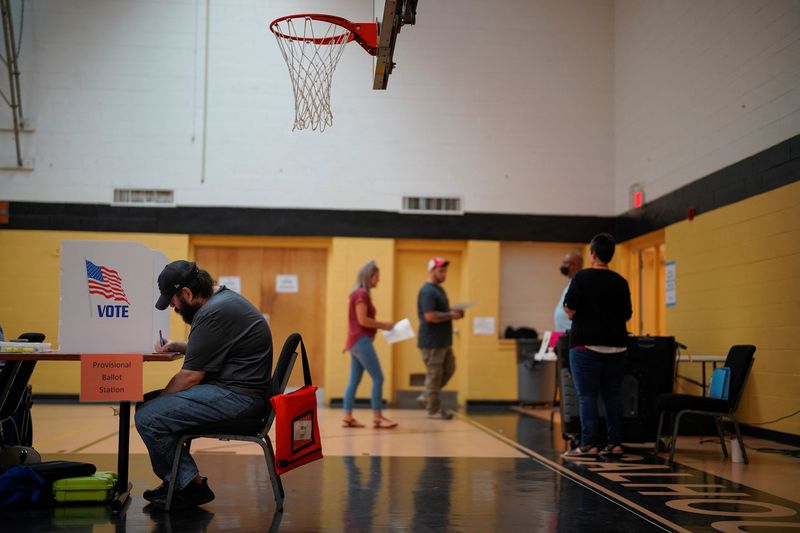Analysis-Takeaways from the U.S. midterm elections
2022.11.08 21:58
[ad_1]

© Reuters. A local resident casts a provisional ballot during the midterm elections at a polling location in Georgia’s 14th congressional district represented by U.S. Republican Congresswoman Marjorie Taylor Greene, in Calhoun, Georgia, U.S., November 8, 2022. REUTE
By James Oliphant
WASHINGTON (Reuters) – The U.S. midterm elections on Tuesday will determine whether Republicans can seize control of Congress from Democrats. At the same time, some governors’ races could determine the future of such issues as abortion and voting rights and potentially shape the 2024 presidential race.
Here are some takeaways from the early results:
STORM CLOUDS
As polls closed across the country, Democrats had largely conceded they were going to lose control of the U.S. House of Representatives to Republicans but hoped to retain a razor-thin majority in the Senate.
Early exit polls from Edison Research, however, showed reason for concern as Democrats appeared to be losing support from crucial voting blocs.
The exit polls showed 54% of voters with college degrees picking Democrats while 45% voted for Republicans. That nine-percentage point advantage was slightly lower than the 12-point spread that Democrat Joe Biden had over Republican Donald Trump among college-educated voters in the 2020 presidential contest.
Of perhaps even greater concern for Democrats was the continued movement of Latinos toward the Republican Party. Exit polls showed Republicans were winning 40% of the Hispanic vote, compared to 32% won by Trump in 2020.
But Democrats could take heart that their share of support from white college-educated women seemed to be holding steady. In 2020, Biden beat Trump among that cohort by about 9 points, according to Edison, and Democrats were leading on Tuesday by a similar margin in the exit polls.
Democrats made protecting abortion rights a central tenet of their midterm election pitch in the closing months – an issue likely to resonate most with college-educated women.
Overall, 52% of all suburban women nationwide were voting for Democrats compared to 47% picking Republicans. That five-percentage point spread was slightly less than the seven-point advantage Biden had over Trump in 2020.
DESANTIS’ NEXT MOVE?
Ron DeSantis took care of business. As expected, he was handily re-elected on Tuesday as governor of Florida.
Now all eyes will be on his next move — and whether he has the guts to take on Donald Trump for the 2024 Republican presidential nomination. Think two gunfighters eyeballing each other on a dusty main street.
That DeSantis is considering a White House run has been an open secret for months even though he never talks about it publicly.
He felt so comfortable about his re-election bid that he frequently left the campaign trail in Florida to stump for other Republicans across the country. His campaign, and the super PAC backing it, amassed a massive war chest, far more than he needed to fend off Democrat Charlie Crist.
Trump has suggested he will announce another presidential bid, perhaps as soon as Nov. 15. He has taken to mocking DeSantis at rallies and arguing that the governor would not be a viable contender for the nomination if he runs.
David Jolly, a former Republican congressman from Florida, said he expects DeSantis to signal his presidential ambitions shortly.
“DeSantis is prepared for a head-to-head primary, and I anticipate he or his team will indicate that in the coming days,” Jolly said. “They believe they can win sufficient delegates to capture the nomination and defeat Trump.”
About 60% of Republicans surveyed by Reuters/Ipsos last month said they thought Trump should run again in 2024, with 36% saying he should not. In an exit poll published by Edison Research on Tuesday, six of 10 respondents said they had an unfavorable opinion of the former president.
A recent poll of Floridians by Victory Insights found Trump and DeSantis knotted at 50% each.
[ad_2]
Source link








